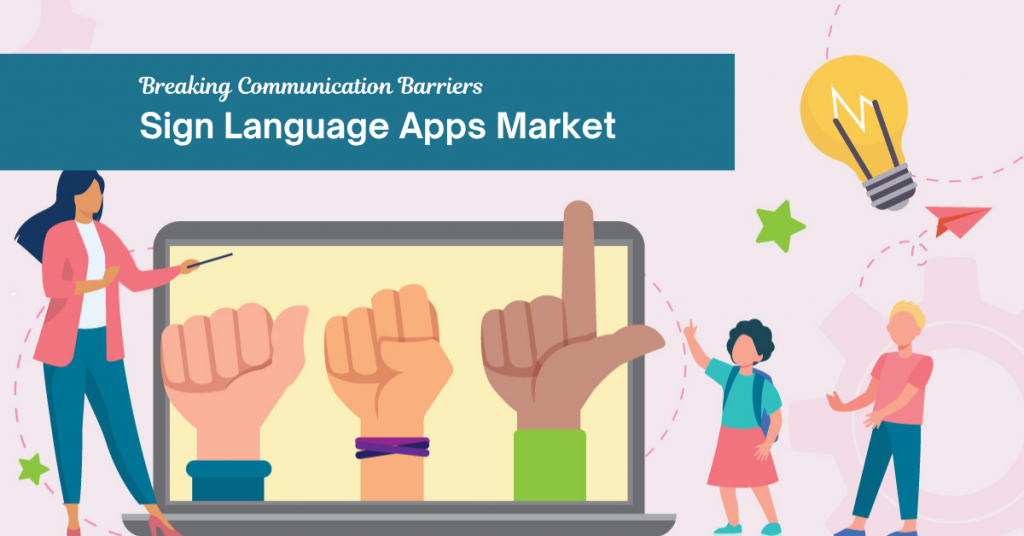
Market Overview
The global Sign Language Apps market has evolved into a crucial part of assistive technology, driving inclusivity and accessibility across multiple sectors. Valued at USD 805.45 million in 2018, the market rose to USD 1,407.34 million in 2024 and is projected to reach USD 3,101.19 million by 2032, registering a robust CAGR of 9.67% during the forecast period. This growth reflects the increasing reliance on digital solutions to support communication for the deaf and hard-of-hearing community.
Sign language apps are transforming how people interact in personal, educational, and professional environments. By providing real-time translation and interactive learning features, these apps empower users to bridge communication barriers. Governments worldwide are emphasizing accessible technology, encouraging developers to innovate solutions tailored for diverse users.
The market’s importance is also underscored by its growing role in healthcare and education, where accurate communication can improve service delivery and learning outcomes. With rising digital adoption, particularly in emerging economies, these apps are becoming more affordable and widely available.
Technological innovations such as AI-driven gesture recognition and AR-based learning modules are expanding the applications of sign language apps beyond basic translation. As organizations and institutions adopt inclusive practices, the market is expected to maintain strong momentum in the coming years, creating opportunities for developers, investors, and users alike.
Read full report: https://www.credenceresearch.com/report/sign-language-apps-market
Market Drivers
Growing Government Support for Accessibility
Government policies promoting inclusivity are becoming a major catalyst for the sign language apps market. Many countries have introduced regulations mandating accessible communication in public services, pushing institutions to adopt such tools. Grants and funding programs are being offered to encourage research and development in assistive technologies. Public-private partnerships are also gaining traction, where technology companies collaborate with government agencies to introduce inclusive apps. These initiatives not only ensure broader adoption but also inspire confidence among users about the reliability of these tools.
Surge in Digital Education and E-Learning Platforms
The rise of e-learning platforms has significantly influenced the demand for sign language apps. Online education providers are incorporating interactive sign language modules to make learning accessible to students with hearing disabilities. Many universities and schools now integrate these apps into their virtual classrooms, ensuring equal participation for all students. EdTech companies are also forming alliances with accessibility technology developers to enhance their offerings. As digital education expands globally, particularly in developing regions, the role of sign language apps will become even more prominent in supporting inclusive learning.
Innovations in Gesture Recognition Technology
Breakthroughs in computer vision and deep learning have transformed the accuracy and responsiveness of sign language apps. Gesture recognition technology now supports more natural and fluid communication, making interactions faster and more reliable. Developers are integrating AI models capable of recognizing subtle hand movements and facial expressions, improving translation quality. Cloud-based AI solutions are enabling real-time updates, ensuring apps remain efficient and up to date with new sign variations. These innovations are encouraging more institutions and individuals to adopt digital sign language solutions for daily communication.
Increasing Corporate Adoption for Workplace Inclusivity
Companies are becoming more proactive in adopting accessibility tools as part of their diversity and inclusion initiatives. Sign language apps are increasingly being integrated into corporate training programs to help employees communicate effectively with hearing-impaired colleagues or clients. Retail, hospitality, and customer service industries are also exploring these apps to enhance customer experience. Businesses view accessibility as not just a legal obligation but also a means to improve brand reputation and customer trust. This growing corporate focus on inclusivity significantly boosts demand for advanced and easy-to-use sign language apps.
Market Challenges
Fragmentation of Sign Language Variations
The existence of multiple sign language variations across regions creates a major challenge for developers. Apps need to support different languages such as American Sign Language (ASL), British Sign Language (BSL), and regional dialects, complicating standardization efforts. Continuous updates are required to keep databases accurate, which increases development costs and delays product rollouts.
Limited Affordability for Low-Income Users
Although smartphone penetration is increasing, affordability remains a challenge in low-income regions. Many advanced apps with premium features are priced beyond the reach of average users. Subscription-based models often discourage adoption in developing countries, limiting the potential market size.
Shortage of Skilled Developers in Accessibility Tech
The creation of high-quality sign language apps demands expertise in AI, gesture recognition, and accessibility design. However, the number of developers with specialized skills in assistive technologies remains limited. This talent shortage slows innovation and restricts the availability of competitive products in the market.
User Skepticism and Learning Curve
Many potential users are hesitant to adopt sign language apps due to concerns over accuracy and ease of use. Older adults and people with limited digital literacy often find it challenging to navigate these apps. Without proper onboarding and training, the adoption rate in certain demographics remains low, despite technological advancements.
Market Opportunity
Rising Demand for Multilingual Support
As global mobility increases, there is growing demand for apps that support multiple sign languages within a single platform. Developers who invest in creating multilingual databases can tap into international markets and serve global users effectively.
Integration with Smart Home and IoT Devices
The rise of smart homes and IoT devices presents a unique opportunity for sign language apps. Integrating gesture-based commands for controlling home appliances could expand the utility of these apps beyond communication. This innovation could particularly benefit users with hearing disabilities, offering them greater convenience and independence.
Partnerships with NGOs and Disability Organizations
Collaborations with non-profit organizations can significantly boost app adoption in underserved regions. NGOs working for disability rights often act as intermediaries to promote awareness and distribute apps to communities in need. Developers who form such partnerships can enhance their brand credibility while reaching wider audiences.
Growth in Telehealth and Remote Consultations
Telehealth platforms are increasingly adopting sign language apps to improve virtual consultations with hearing-impaired patients. Healthcare providers are realizing the importance of accurate communication for better diagnosis and treatment. This growing telehealth trend offers developers new opportunities to create specialized medical communication modules.
Market Segmentation
By Platform
- iOS Apps
- Android Apps
- Web-based Deployments
By Deployment
- Cloud-based
- On-premises
By Subscription
- Free Apps
- Paid Apps
- Subscription-based Services
- Freemium Models
By Application
- Language Learning & Education
- Communication Tools
- Accessibility Solutions
- Interpreter Support
- Others
By Geography
North America
- U.S.
- Canada
- Mexico
Europe
- UK
- France
- Germany
- Italy
- Spain
- Russia
- Belgium
- Netherlands
- Austria
- Sweden
- Poland
- Denmark
- Switzerland
- Rest of Europe
Asia Pacific
- China
- Japan
- South Korea
- India
- Thailand
- Indonesia
- Vietnam
- Malaysia
- Philippines
- Taiwan
- Rest of Asia Pacific
Latin America
- Brazil
- Argentina
- Peru
- Chile
- Colombia
- Rest of Latin America
Middle East & Africa
- GCC Countries
- South Africa
- Rest of the Middle East and Africa
Regional Analysis
North America continues to lead the market, supported by strong regulatory frameworks and advanced technological infrastructure. The US dominates due to widespread adoption in education and healthcare, while Canada is rapidly adopting similar practices through government-backed accessibility initiatives. Major tech firms in this region are heavily investing in research to create innovative and affordable solutions.
Europe is also a significant market, with countries like the UK, Germany, and France at the forefront of adoption. Strict EU accessibility laws and public funding for inclusive technologies drive this growth. Collaborative projects between universities, governments, and private companies are resulting in advanced educational tools. Additionally, European users are receptive to premium subscription models, boosting developer revenues.
Asia-Pacific is witnessing the fastest growth, with China, Japan, and India emerging as key markets. Government-led disability inclusion programs and rapid digitalization are creating favorable conditions. Startups in India and Southeast Asia are introducing localized, low-cost apps to cater to regional needs.
Latin America is steadily expanding, with Brazil and Argentina showing positive growth due to improved connectivity and NGO-led awareness campaigns. The Middle East & Africa, though still developing, is expected to gain momentum as smart city initiatives in GCC countries prioritize accessibility technologies.
Top Companies
- Microsoft
- ProDeaf
- SignSchool
- Hand Talk
- ASL App / The ASL App
- GestureTek
- Signily
- Lingvano
Future Outlook
- AI-driven gesture recognition will evolve further, reducing translation errors significantly.
- AR-based interactive modules will make sign language learning more engaging for students.
- Wearable devices with built-in sign language interpretation will enter mainstream use.
- Telehealth platforms will increasingly adopt specialized apps for patient communication.
- Emerging markets will see rapid adoption as localized, low-cost apps become widely available.
- More educational institutions will integrate these apps into regular classroom teaching.
- Partnerships with major corporations will create enterprise-focused sign language solutions.
- Governments will mandate accessible communication tools in public services.
- Developers will focus on hybrid platforms supporting multiple sign languages simultaneously.
- Competitive innovation will result in affordable apps with enhanced real-time translation features.
Read full report: https://www.credenceresearch.com/report/sign-language-apps-market


